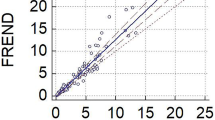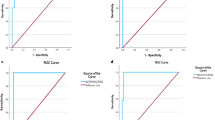Abstract
Neonatal hypothyroidism is a deficiency of thyroid hormones at birth that can cause lifelong mental and physical disorders in humans. Lack of timely detection could lead to irreversible damage by neonatal hypothyroidism. However, it could be managed quickly and efficiently via timely diagnosis. The screening programs rely on immunoassays to diagnose neonatal hypothyroidism in most countries. This method is time-consuming, needs laboratory equipment, and should be performed by trained and skilled technicians. Given these circumstances, the ELISA method is not a preferable method for the diagnosing of neonatal hypothyroidism. However, it can be used as a confirmatory method in infants with suspected and unknown neonatal hypothyroidism. In the present study, the homemade SR95-1, SR95-2, and SR95-3 anti-β-TSH polyclonal and the commercially available monoclonal antibodies were used to detect β-TSH in a rapid assay kit design hypothyroidism screening. To design the kit, the different combinations of the antibodies were used to establish a sandwich immune-chromatography method. The designed rapid neonatal hypothyroidism tests were used to measure neonatal β-TSH in 100 dry blood samples. This study showed that the best antibody pair in terms of sensitivity is the SR95-1 antibody as capture antibody and the SR95-2 as a conjugated antibody. Using 100 clinical samples, the designed assay was shown to have 94% sensitivity, 83% specificity, and 94% accuracy. The results showed that polyclonal antibodies (SR95-1 as capture) and SR95-2 (as detector) antibodies can detect the reference range of β-TSH in dried blood samples and can be used in the screening of neonatal hypothyroidism.




Similar content being viewed by others
Data Availability
The authors confirm that the data supporting the findings of this study are available within the article.
Change history
20 August 2022
A Correction to this paper has been published: https://doi.org/10.1007/s12010-022-04109-x
14 July 2022
A Correction to this paper has been published: https://doi.org/10.1007/s12010-022-04071-8
References
Toloza, F. J., Motahari, H., & Maraka, S. (2020). Consequences of severe iodine deficiency in pregnancy: evidence in humans. Frontiers in Endocrinology, 11, 409.
González-Irazabal, Y., Hernandez de Abajo, G., Martínez-Morillo, E. (2020). Identifying and overcoming ba-rriers to harmonize newborn screening programs through consensus strategies [published online ahead of print, 2020 Jul 21]. Critical Reviews in Clinical Laboratory Sciences. 2020;1–20. https://doi.org/10.1080/10408363.2020.1781778
Aubry, G., Pontvianne, M., Chesnais, M., Weingertner, A. S., Guerra, F., & Favre, R. (2017). Prenatal diagnosis of fetal goitrous hypothyroidism in a euthyroid mother: A management challenge. Journal of Ultrasound in Medicine, 36(11), 2387–2392.
Jacob, H., & Peters, C. (2015). Screening, diagnosis and management of congenital hypothyroidism: European Society for Paediatric Endocrinology Consensus Guideline. Archives of Disease in Childhood-Education and Practice, 100(5), 260–263.
Yoon, S. A., Chang, Y. S., Ahn, S. Y., et al. (2019). Initial and delayed thyroid-stimulating hormone elevation in extremely low-birth-weight infants. BMC Pediatrics, 19, 347.
Baksi, S., & Pradhan, A. (2021). Thyroid hormone: sex-dependent role in nervous system regulation and disease. Biol Sex Differ, 12, 25.
Woo, H. C., Lizarda, A., Tucker, R., Mitchell, M. L., Vohr, B., Oh, W., & Phornphutkul, C. (2011). Congenital hypothyroidism with a delayed thyroid-stimulating hormone elevation in very premature infants: Incidence and growth and developmental outcomes. The Journal of pediatrics, 158(4), 538–542.
Oron, T., Lazar, L., Ben-Yishai, S., Tenenbaum, A., Yackobovitch-Gavan, M., Meyerovitch, J., ... & Lebenthal, Y. (2018). Permanent vs transient congenital hypothyroidism: assessment of predictive variables. Journal of Clinical Endocrinology & Metabolism, 103(12), 4428-4436.
Ragusa, F., Fallahi, P., Elia, G., et al. (2019). Hashimotos’ thyroiditis: Epidemiology, pathogenesis, clinic and therapy. Best Pract Res Clin Endocrinol Metab, 33, 101367.
Lauffer, P., van Trotsenburg, A. S. P., & Zwaveling-Soonawala, N. (2021). Low free thyroxine and normal thyroid-stimulating hormone in infants and children: Possible causes and diagnostic work-up. European Journal of Pediatrics. https://doi.org/10.1007/s00431-021-03976-6
Van Trotsenburg, A. S. P. (2020). Management of neonates born to mothers with thyroid dysfunction, and points for attention during pregnancy. Best Pract Res Clin Endocrinol Metab, 34, 101437.
Maniatis, A. K., Taylor, L., Letson, G. W., Bloch, C. A., Kappy, M. S., & Zeitler, P. (2006). Congenital hypothyroidism and the second newborn metabolic screening in Colorado, USA. Journal of Pediatric Endocrinology and Metabolism, 19(1), 31–38.
Peters, C., Van Trotsenburg, A. S. P., & Schoenmakers, N. (2018). DIAGNOSIS OF ENDOCRINE DISEASE: Congenital hypothyroidism: Update and perspectives. European journal of endocrinology, 179(6), R297–R317.
McCandless, S. E., & Wright, E. J. (2020). Mandatory newborn screening in the United States: History, current status, and existential challenges. Birth defects research, 112(4), 350–366.
Alexander, E. K., Pearce, E. N., Brent, G. A., et al. (2017). Guidelines of the American Thyroid Association for the diagnosis and management of thyroid disease during pregnancy and the postpartum. Thyroid., 27(3), 315–389.
Bauer, A. J., & Wassner, A. J. (2019). Thyroid hormone therapy in congenital hypothyroidism and pediatric hypothyroidism. Endocrine, 66, 51–62. https://doi.org/10.1007/s12020-019-02024-6
Pode-Shakked N, Blau A, Pode-Shakked B, et al. (2019).Combined gestational age- and birth weight-adjusted cutoffs for newborn screening of congenital adrenal hyperplasia [published online ahead of print March 13, 2019]. Journal of Clinical Endocrinology and Metabolism. https://doi.org/10.1210/jc.2018-02468pmid:30865229. 26.
Vincent, M. A., Rodd, C., Dussault, J. H., & Van Vliet, G. (2002). Very low birth weight newborns do not need repeat screening for congenital hypothyroidism. The Journal of pediatrics, 140(3), 311–314.
Van Belkum, A., Burnham, C. A. D., Rossen, J. W. A., et al. (2020). Innovative and rapid antimicrobial susceptibility testing systems. Nature Reviews Microbiology, 18, 299–311. https://doi.org/10.1038/s41579-020-0327-x
Camilo, D. E., Miyazaki, C. M., Shimizu, F. M., & Ferreira, M. (2019). Improving direct immunoassay response by layer-by-layer films of gold nanoparticles–antibody conjugate towards label-free detection. Materials Science and Engineering: C, 102, 315–323.
Yuan, J., Chen, X., Duan, H, Cai X., Li, Y, Guo, L, Huang, X, Xiong, Y. (2020). Gold nanoparticle–decorated metal organic frameworks on immunochromatographic assay for human chorionic gonadotropin detection. Microchimica Acta , 187 (12) https://doi.org/10.1007/s00604-020-04617-9
Li, J., & Macdonald, J. (2016). Multiplexed lateral flow biosensors: Technological advances for radically improving point-of-care diagnoses. Biosens Bioelectron, 85, 998–999. 83, pp. 177-192.
Abdulwahab, M., Khan, A. A., Abdallah, S. H., et al. (2021). Arylated gold nanoparticles have no effect on the adipogenic differentiation of MG-63 cells nor regulate any key signaling pathway during the differentiation. BMC Res Notes, 14, 192. https://doi.org/10.1186/s13104-021-05594-9
Sajid, M., Kawde, A. N., & Daud, M. (2015). Designs, formats and applications of lateral flow assay: A literature review. J Saudi Chem Soc, 19, 689–705.
Mard-Soltani, M., Rasaee, M. J., Khalili, S., Sheikhi, A., Hedayati, M., Ghaderi-Zefrehi, H., & Alasvand, M. (2018). The effect of differentially designed fusion proteins to elicit efficient anti-human thyroid stimulating hormone immune responses. Iranian Journal of Allergy, Asthma and Immunology, 17(2), 158-170. 43.
Jones, N. H. Y., Rose, S. R. (2018) Congenital Hypothyroidism. In: Radovick S., Misra M. (eds) Pediatric Endocrinology. Springer, Cham. https://doi.org/10.1007/978-3-319-73782-9_17.
Evin, F., Balkı, H. G., Ata, A., Er, E., Vatansever, Z., Özen, S., ... & Darcan, Ş. (2022). Prediction of transient or permanent congenital hypothyroidism. Journal of Pediatric Research, 9(1), 38–45. https://doi.org/10.4274/jpr.galenos.2021.55707
Cassio, A., Corbetta, C., Antonozzi, I., et al. (2013). The Italian screening program for primary congenital hypothyroidism: Actions to improve screening, diagnosis, follow-up, and surveillance. Journal of Endocrinological Investigation, 36, 195–203. https://doi.org/10.3275/8849
Hertzberg, V., Mei, J., & Therrell, B. L. (2010). Effect of laboratory practices on the incidence rate of congenital hypothyroidism. Pediatrics., 125(Suppl 2), 48-53.53.
Lou, S., Ye, J. Y., Li, K. Q., & Wu, A. (2012). A gold nanoparticle - based immunochromatographic assay: the influence of nanoparticulate size. The Analyst., 137(5), 1174–81.
Hall, S. K., Hutchesson, A. C., Kirk, J. M. (1992). Congenital hypothyroidism, seasonality and consanguinity in the West Mid lands, England. Acta paediatrica (Oslo, Norway: 1992). 1999; 88 (2):2125
World Health Organization.(2019). WHO model list of essential medicines. 2017. http://apps.who.int/iris/bitstream/handle/10665/273826/EML-20-eng.pdf?ua=1. Accessed 4 Jan 2019.
Worth, C., Hird, B., Tetlow, L., Wright, N., Patel, L., & Banerjee, I. (2021). Thyroid scintigraphy differentiates subtypes of congenital hypothyroidism. Archives of disease in childhood, 106(1), 77–79.
Acknowledgements
The authors wish to thank Payame Noor University and Dezful University of Medical Sciences for supporting the conduct of this research. We also thank the Dezful University of Medical Sciences Research Center for its cooperation and provision of the necessary facilities for this research.
Author information
Authors and Affiliations
Contributions
All authors contributed to the study’s conception and design. Material preparation, data collection, and analysis were performed by [Maysam Mard-Soltani], [Neda Shakarian], and [Saeed Khalili]. The first draft of the manuscript was written by [Neda Shakarian], and all authors commented on previous versions of the manuscript. All authors read and approved the final manuscript.
Corresponding author
Ethics declarations
Participation of the authors
Dr. Maysam Mard-Soltani designed the study, expressed and purified the recombinant protein and prepared the conjugated antibody. Dr. Sima Nasri analyzed the data and corrected the manuscript. Ms. Neda Shakarian did the laboratory work of the project and analyzed the data and wrote the manuscript. All the authors helped to analyze and discuss the results.
Consent to Participate
Informed consent was obtained from all individual participants included in the study.
Consent to Publish
not applicable
Informed consent
Parents of all study participants received a full explanation of the study and were obtained a written informed consent prior to their inclusion in the study.
Research involving human participants and/or animals
All procedures were performed according to the ethical guidelines of the review board of Payame Noor University of East Tehran (ID: IR.PNU.REC.1399.045).
Conflicts of interest/Competing interests
The authors report no conflict of interest.
Additional information
Publisher's note
Springer Nature remains neutral with regard to jurisdictional claims in published maps and institutional affiliations.
Rights and permissions
Springer Nature or its licensor holds exclusive rights to this article under a publishing agreement with the author(s) or other rightsholder(s); author self-archiving of the accepted manuscript version of this article is solely governed by the terms of such publishing agreement and applicable law.
About this article
Cite this article
Shakerian, N., Mard-Soltani, M., Nasri, S. et al. Different combinations of monoclonal antibodies and polyclonal antibodies in the design of neonatal hypothyroidism diagnostic kit. Appl Biochem Biotechnol 194, 3167–3181 (2022). https://doi.org/10.1007/s12010-022-03888-7
Received:
Accepted:
Published:
Issue Date:
DOI: https://doi.org/10.1007/s12010-022-03888-7




